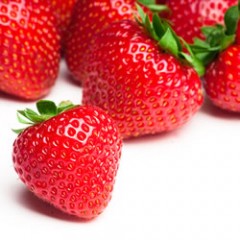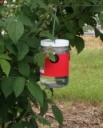Strawberries
 New York State ranks 8th in the nation in strawberry production. Statewide there are over 1700 acres in production yielding 3.6 million pounds with a cash value of nearly 8.5 million dollars. The vast majority of the crop is sold from late May into early July as part of the June bearing crop that is grown in a perennial matted row system. This crop has a significant emotional bond with consumers. Strawberries have long been the first locally grown crop of the season. Picking strawberries is one of the most popular agricultural activities in upstate NY with most communities hosting delicious strawberry festivals. Ninety-five percent of the crop is sold this way, often picked by customers and always for immediate fresh consumption. The remaining 5% of the crop is used for value-added processing.
New York State ranks 8th in the nation in strawberry production. Statewide there are over 1700 acres in production yielding 3.6 million pounds with a cash value of nearly 8.5 million dollars. The vast majority of the crop is sold from late May into early July as part of the June bearing crop that is grown in a perennial matted row system. This crop has a significant emotional bond with consumers. Strawberries have long been the first locally grown crop of the season. Picking strawberries is one of the most popular agricultural activities in upstate NY with most communities hosting delicious strawberry festivals. Ninety-five percent of the crop is sold this way, often picked by customers and always for immediate fresh consumption. The remaining 5% of the crop is used for value-added processing.With the advent of ever-bearing (also called day neutral) varieties many strawberry farmers have been able to offer NY consumers high quality, locally grown fresh strawberries later in the season - from August to November. Other production innovations include growing on plastic mulch to help reduce herbicide inputs and growing strawberries in high tunnels to lower the incidence of botrytis gray mold and other pests.
For more information about strawberry production, visit the Cornell Berry website.
Labeled Insecticides for Control of Spotted Wing Drosophila in NY Berry Crops
Laura McDermott, Team Leader, Small Fruit and Vegetable Specialist
Eastern New York Commercial Horticulture
Labeled Insecticides for Control of Spotted Wing Drosophila in New York Berry Crops - Quick Guide
Updated May 2024
2023 Labeled Insecticides for Control of Spotted Wing Drosophila in NY Berries
Laura McDermott, Team Leader, Small Fruit and Vegetable Specialist
Eastern New York Commercial Horticulture
May 2023 - Labeled Insecticides for Control of Spotted Wing Drosophila in New York Berry Crops - Quick Guide
2022 SWD Quick Guide
Laura McDermott, Team Leader, Small Fruit and Vegetable Specialist
Eastern New York Commercial Horticulture
June 2022 - Labeled Insecticides for Control of Spotted Wing Drosophila in New York Berry Crops - Quick Guide
First Year Impressions: Using Low Tunnels to Improve June-Bearing Strawberries
Laura McDermott, Team Leader, Small Fruit and Vegetable Specialist
Eastern New York Commercial Horticulture
June-bearing (JB) strawberry growers know that the first berries to market in the spring fetch the highest prices and draw in customers. With more and more high tunnels being constructed on farms every year, growers are interested in the utility of tunnels for strawberries versus tomatoes and other warm-season crops. We see a wide variety of strawberry production under cover around the state, ranging from sophisticated greenhouses with hydroponic production to high tunnels and smaller caterpillar tunnels. These structures help extend the season for JB strawberries, hastening maturity in May. They also protect plants from rain and extreme weather events, reducing disease pressure. Although larger tunnel structures are a more common site in NY farms, we seldom see low tunnels—waist-high plastic structures—on farms.
Fall Weed Control in Berry Crops
Laura McDermott, Team Leader, Small Fruit and Vegetable Specialist
Eastern New York Commercial Horticulture
Late summer and fall is a good time to work on tough-to-control perennial weeds such as Virginia creeper vine, grapevine, milkweed, goldenrod, poison ivy and brambles. These perennials generally do not respond to soil applied herbicides, but can be managed by careful applications of glyphosate (Roundup) in the fall. Glyphosate is effective on these weeds, but will also kill berry plants. Perennial weeds succumb because the plant is moving carbohydrate reserves down into the root system at this time of year. So treated leaves quickly move the systemic herbicide glyphosate down into the crown and root. You need to treat before the leaves drop though - so the clock is ticking. Some woody weeds like Virginia creeper vine, drops its leaves early in the fall.
Keeping Plants Clean from Viruses
Laura McDermott, Team Leader, Small Fruit and Vegetable Specialist
Eastern New York Commercial Horticulture
Viruses can be a menace to berry crops. A single breeding selection or mother plant can easily be propagated to millions of daughter plants, and if the mother plant is infected, all daughter plants will also be infected. An infected plant could translate to poor establishment and loss of yield and could possibly lead to the need for growers to replant. For these reasons, virologists put a lot of effort into virus testing and elimination.
SWD Insecticides Quick Guide 2020
Laura McDermott, Team Leader, Small Fruit and Vegetable Specialist
Eastern New York Commercial Horticulture
June 2020 - Labeled Insecticides for Control of Spotted Wing Drosophila in New York Berry Crops - Quick Guide
Understanding Strawberry Root Problems That Impact Berry Farm Profitability
Laura McDermott, Team Leader, Small Fruit and Vegetable Specialist
Eastern New York Commercial Horticulture

Weed pressure, root disease, plant parasitic nematodes and soil insects have all been identified by strawberry industry groups as barriers to success with strawberry production in the northeast United States. Research into best management practices has revealed that cover cropping and proper crop rotation will significantly reduce the impact of disease on strawberry production, these recommendations however, are not being used on all farms.
Overwintering Strawberries - Timing of Fall Mulch Application and Spring Removal
Laura McDermott, Team Leader, Small Fruit and Vegetable Specialist
Eastern New York Commercial Horticulture
Successful overwintering of strawberries is a tricky business and not giving it enough consideration can result in poor yield the following year.
Labeled Insecticides for Control of Spotted Wing Drosophila
Laura McDermott, Team Leader, Small Fruit and Vegetable Specialist
Eastern New York Commercial Horticulture

June 2018 - Labeled Insecticides for Control of Spotted Wing Drosophila in New York Berry Crops - Quick Guide
Spray Guidelines to Manage Fungicide Resistance
Laura McDermott, Team Leader, Small Fruit and Vegetable Specialist
Eastern New York Commercial Horticulture

Here's a strawberry spray guide that manages fungicide resistance, when your main objective is gray mold (Botrytis) protection:
Weed Management in Strawberries - an IPM Approach - Video

Dr. Bryan Brown, Integrated Weed Management Specialist with the New York State Integrated Pest Management Program, begins by discussing general weed management principles, then reviews the weed control recommendations of the Cornell Pest Management Guidelines for Berry Crops, and finishes with a case study of Shenk Berry Farm.
2018 Eastern New York Fruit & Vegetable Conference Small Fruit Presentations

Presentations from the 2018 ENYCHP Eastern New York Fruit & Vegetable Conference held February 20th and 21st for the small fruit section.
Labeled Insecticides for Control of Spotted Wing Drosophila in New York Berries
A Quick Guide to Labeled Insecticides for Control of Spotted Wing Drosophila in New York Berry Crops
Compiled by Greg Loeb, Laura McDermott, Peter Jentsch, Tess Grasswitz, & Juliet Carroll, Cornell University. Updated regularly.
Insecticides to Control Spotted Wing Drosophila

Current 2016 SWD Insecticides and Rates
2016 Berry School - Disease Diagnosis Talk
Anne Mills, Field Technician
Eastern New York Commercial Horticulture
2016 Berry School - Disease Management Talk
Anne Mills, Field Technician
Eastern New York Commercial Horticulture
Berry School 2016- Small Fruit Resources
Anne Mills, Field Technician
Eastern New York Commercial Horticulture
The Commercial Storage of Fruits, Vegetables, and Florist and Nursery Stocks
Craig Kahlke, Team Leader, Fruit Quality Management
Lake Ontario Fruit Program
The information contained in this preliminary version of HB-66 has been assembled from information prepared by nearly 100 authors from around the world. The version posted here is a revised copy of a Draft made available online in November 2002 for author and public review and comment.
Strawberry Specific Insecticides for SWD

Spotted Winged Drosophila found locally and throughout New York and New England
Laura McDermott, Team Leader, Small Fruit and Vegetable Specialist
Eastern New York Commercial Horticulture

In light of these findings, blueberry, summer and fall raspberry and day-neutral strawberry growers are urged to be vigilant about this pest.
Designing a Better Sprayer for Pesticide Application in Strawberries
Laura McDermott, Team Leader, Small Fruit and Vegetable Specialist
Eastern New York Commercial Horticulture
Strawberry growers using conventional boom sprayers find it difficult to obtain good disease and insect control due to poor pesticide coverage on the undersides of leaves, on the lower leaves, and on the fruit when the strawberry plant is in full canopy. Inadequate crop protectant coverage results in higher levels of disease and insect activity translating to consumer rejection of poor quality fruit and lower overall profitability of the planting.
This project allowed an opportunity to work with strawberries: a high value crop with a low, 3-dimensional canopy. Strawberry diseases are a big concern for growers, so adequate spray coverage is important; better coverage would allow growers to make fewer applications of fungicides during the growing season.

Upcoming Events
Ag Labor Road Show IX
December 1, 2025 : Save the Date! - Ag Labor Roadshow Webinar 1
In addition to the in-person Ag Labor Roadshow program in our region on December 9, two webinars are scheduled for December 1 and December 22. Each webinar will focus on different program content that is different from the in-person sessions. These webinars are an added benefit to program registration.
December 9, 2025 : Save the Date - Ag Labor Road Show In-Person Event (Greenwich, NY)
Greenwich, NY
The Roadshow delivers essential updates on labor law, regulations, and workforce best practices—tailored for farm owners, managers, and ag service providers. Sessions also focus on practical strategies to boost communication, strengthen retention, and build a positive workplace culture.
The in-person session for Eastern NY is December 9 - Elks Lodge, Greenwich, NY - full day in person session
Additional in-person sessions are:
December 10 - Hilton Garden Inn, Watertown, NY, December 17 - Cornell AgriTech, Geneva, NY, December 18 - Genesee Community College, Batavia, NY
December 22, 2025 : Save the Date! - Ag Labor Roadshow Webinar 2
In addition to the in-person Ag Labor Roadshow program in our region on December 9, two webinars are scheduled for December 1 and December 22. Each webinar will focus on different program content that is different from the in-person sessions. These webinars are an added benefit to program registration.
How to Obtain a Pesticide Applicator License
December 17, 2025
Thinking about becoming a certified pesticide applicator in New York, but aren't sure where to start? Join DEC representative Kenneth Klubek for a discussion on who needs to become a certified pesticide applicator, certification types, examination procedures, and recertification. Participants will have ample opportunity to ask questions during the program.
2026 Winter Cut Flower Webinar Series
January 6, 2026 : Session 1: Cut Flower Cost Calculator Updates and Woody Cuts
Session 1: Cut Flower Cost Calculator Updates and Woody Cuts
January 13, 2026 : Session 2: Perennials and Industry Trends
Session 2: Perennials and Industry Trends
January 20, 2026 : Session 3: Anaerobic Soil Disinfestation and Biochar
Session 3: Anaerobic Soil Disinfestation and Biochar
January 27, 2026 : Session 4: Beneficial Insects and Propagation Techniques
Session 4: Beneficial Insects and Propagation Techniques
February 3, 2026 : Session 5: Fungal and Insect Pests and Market Trends
Session 5: Fungal and Insect Pests and Market Trends












































